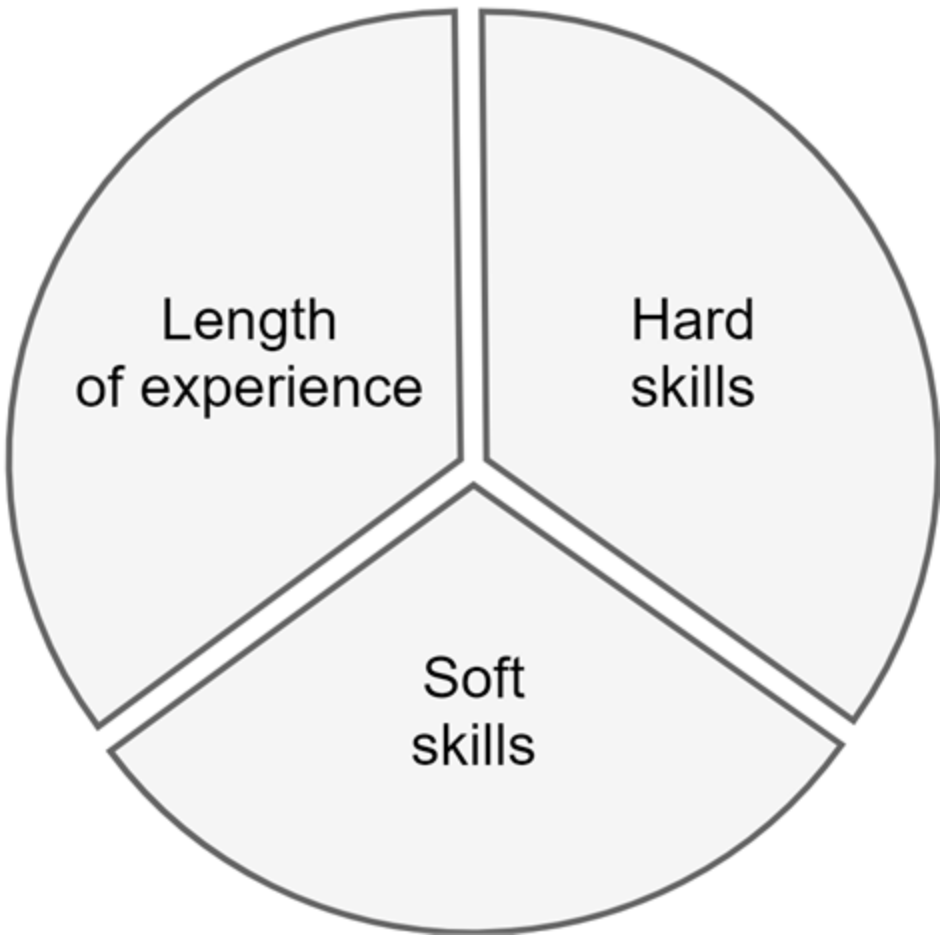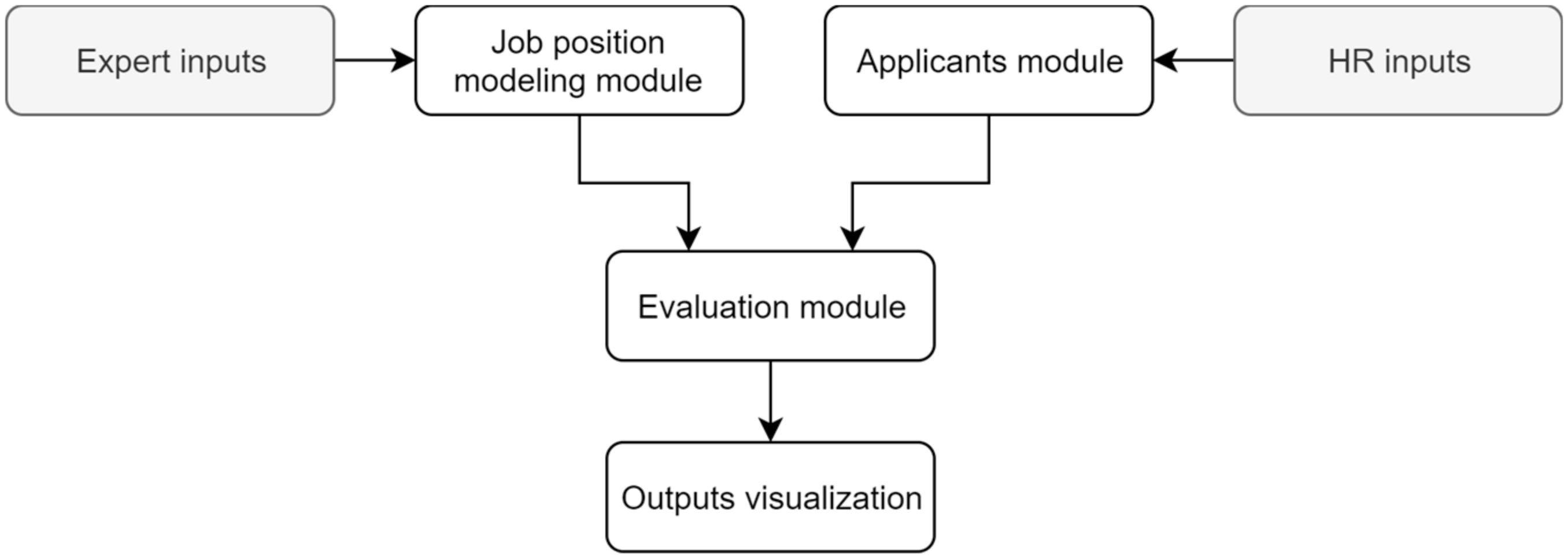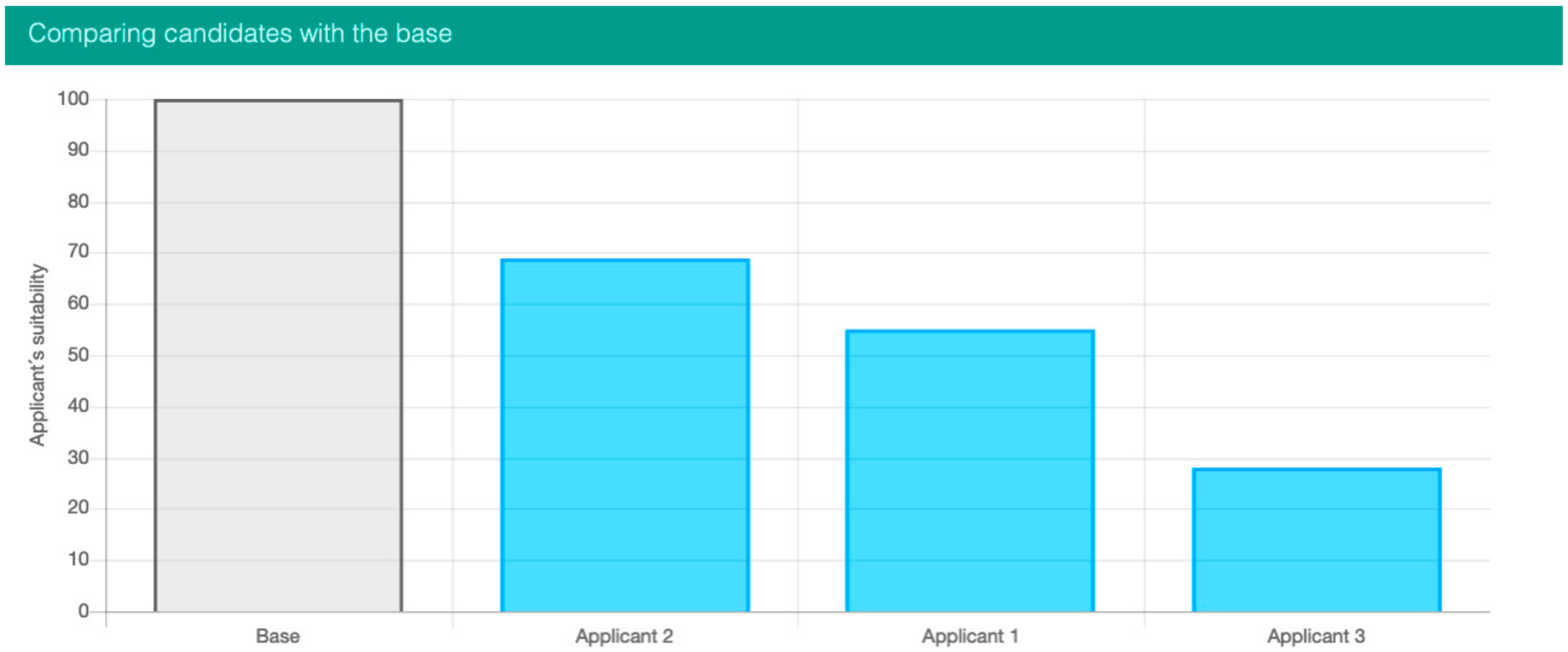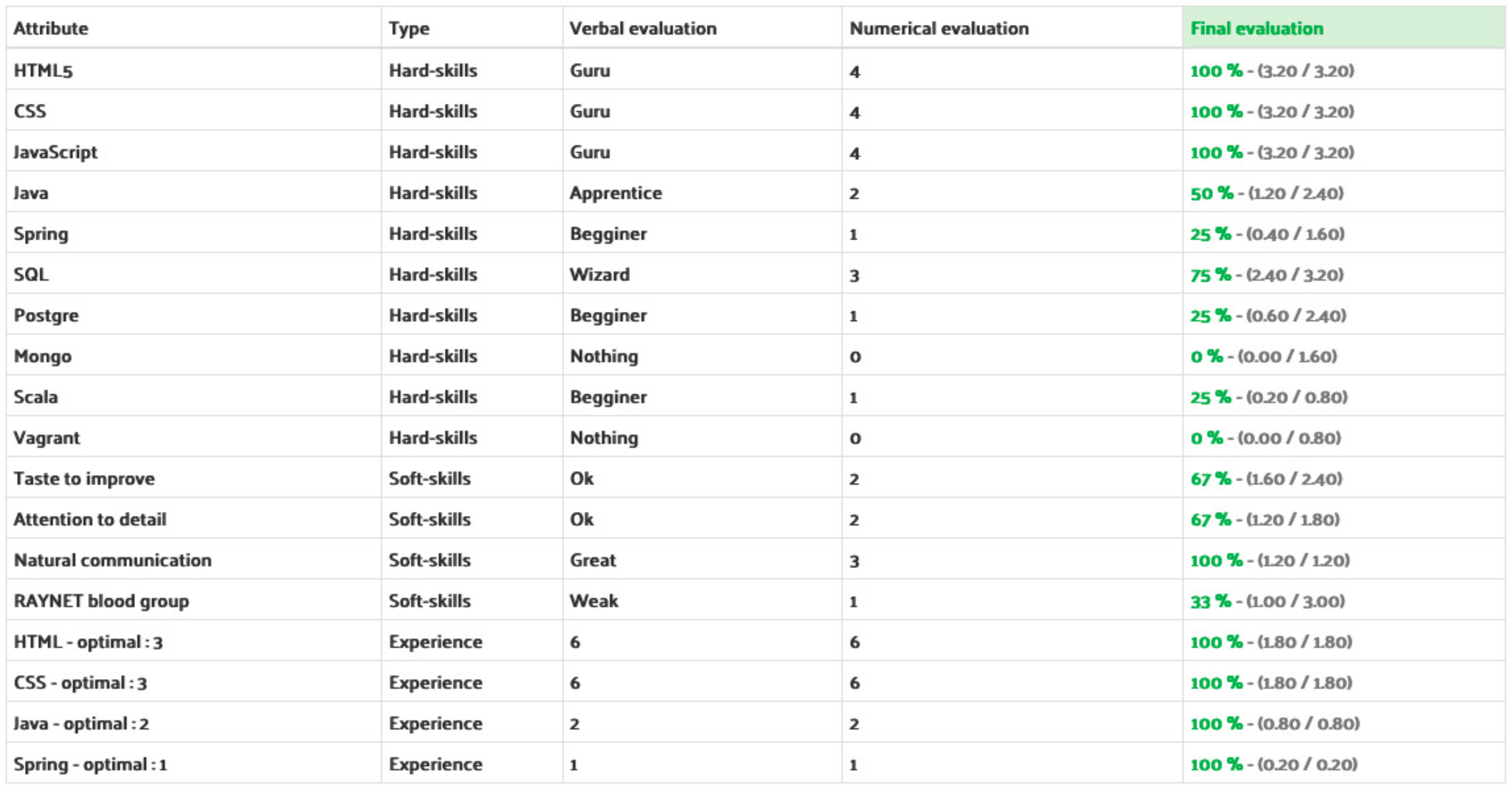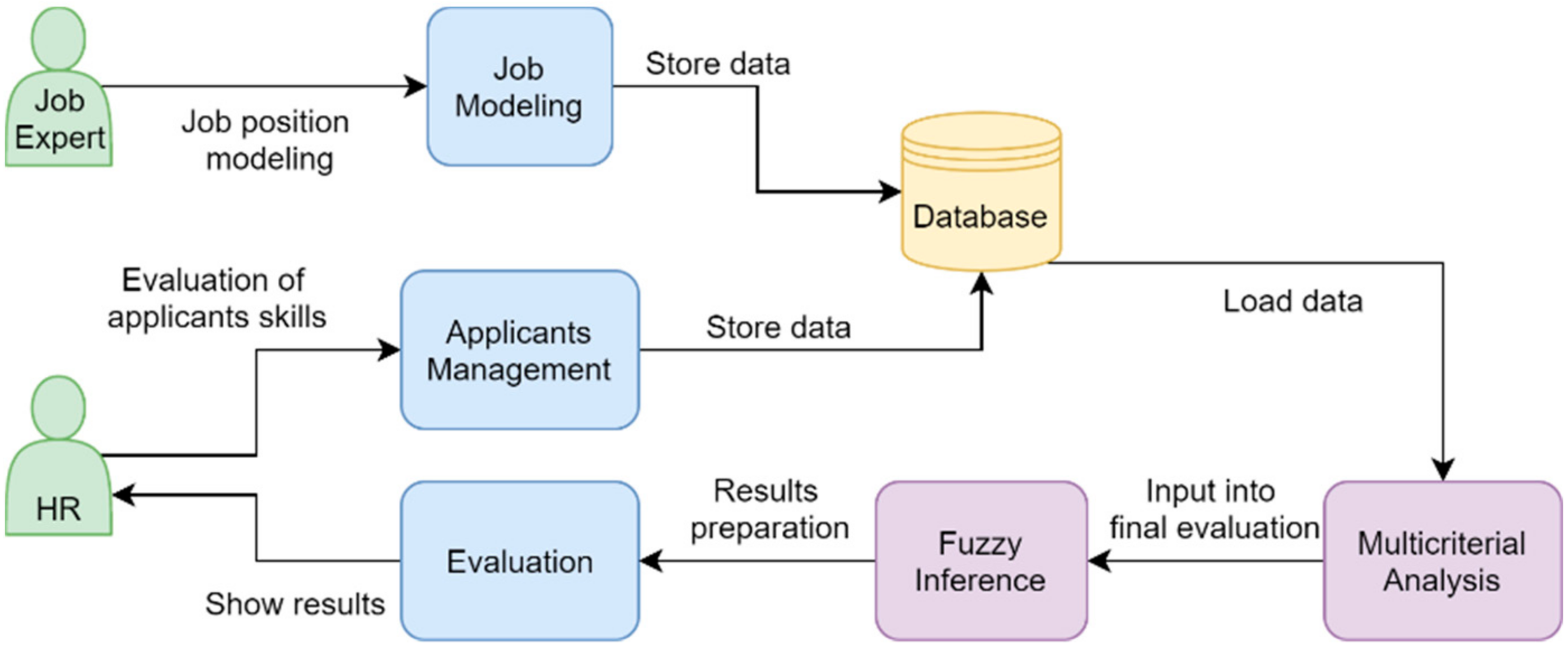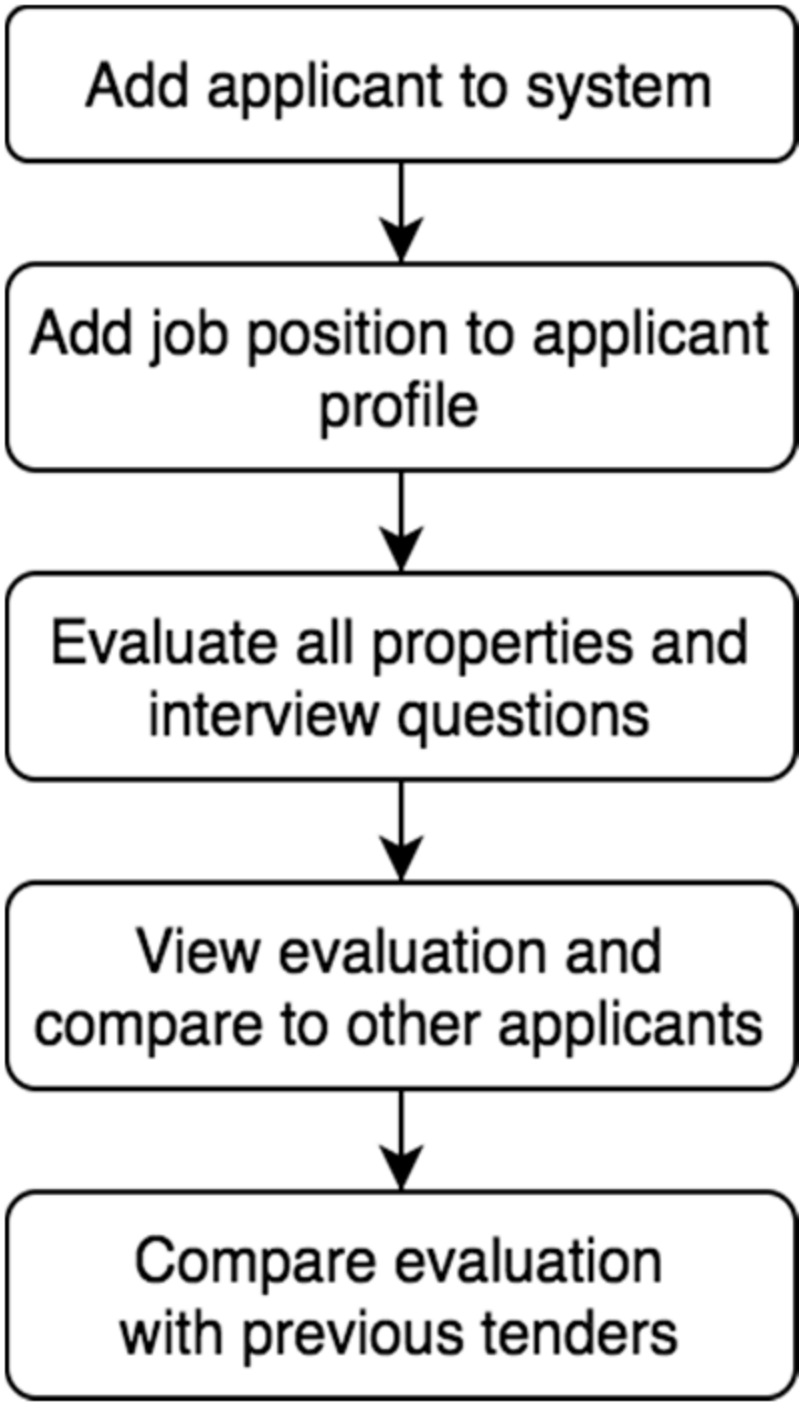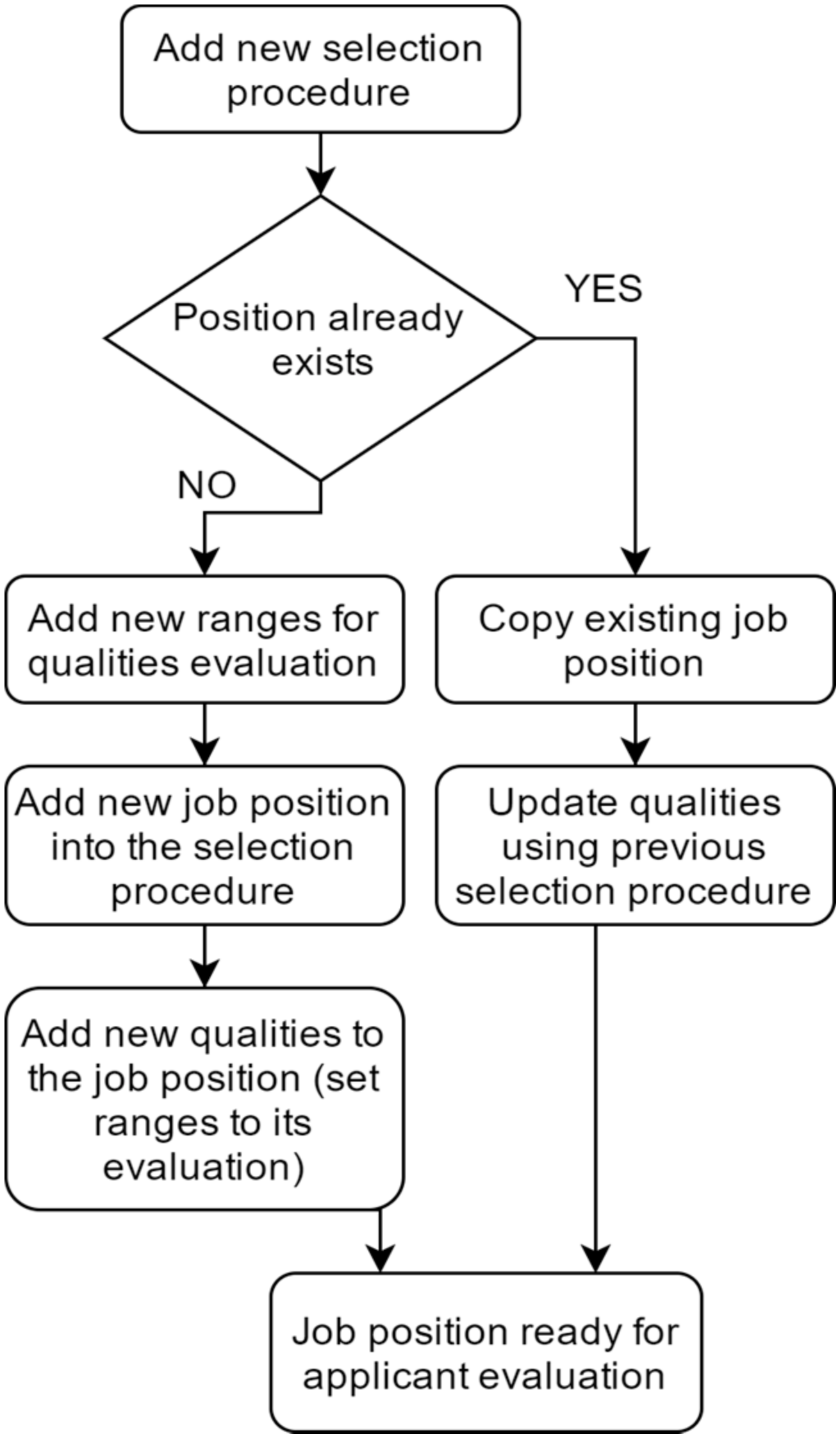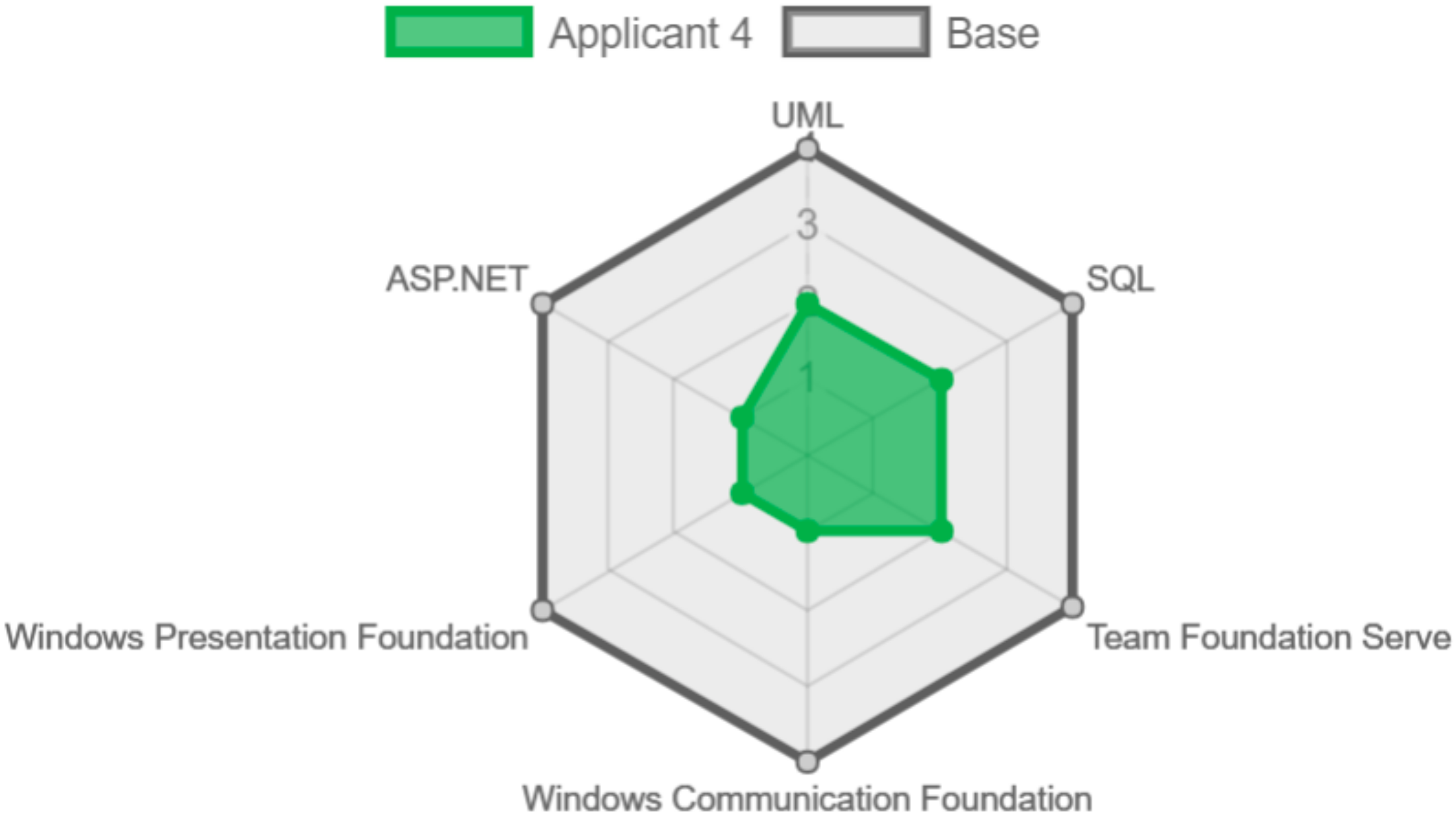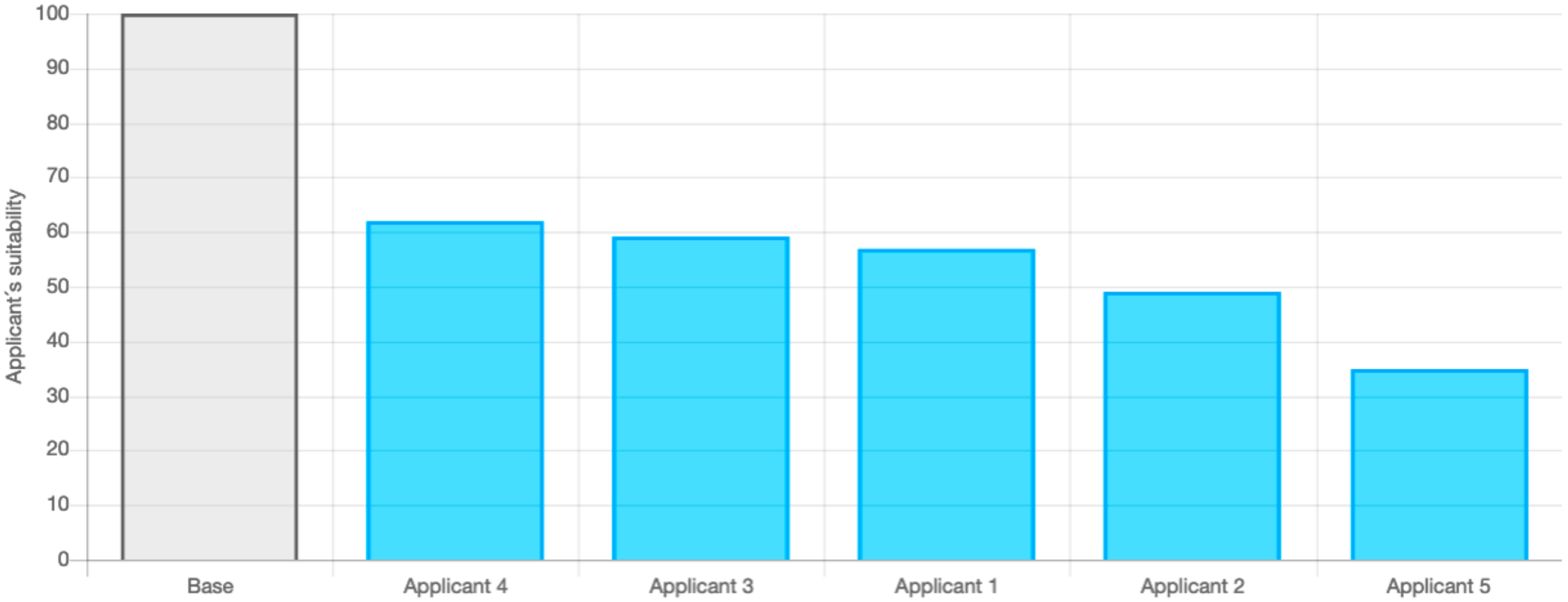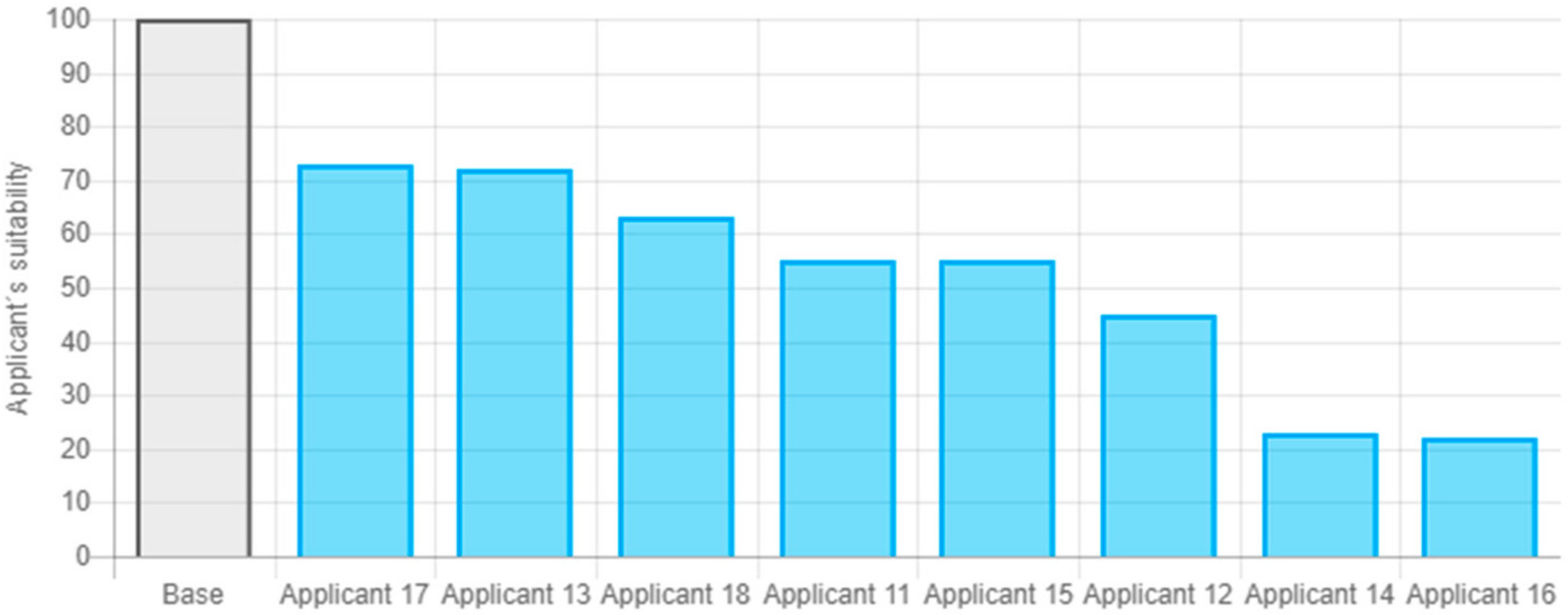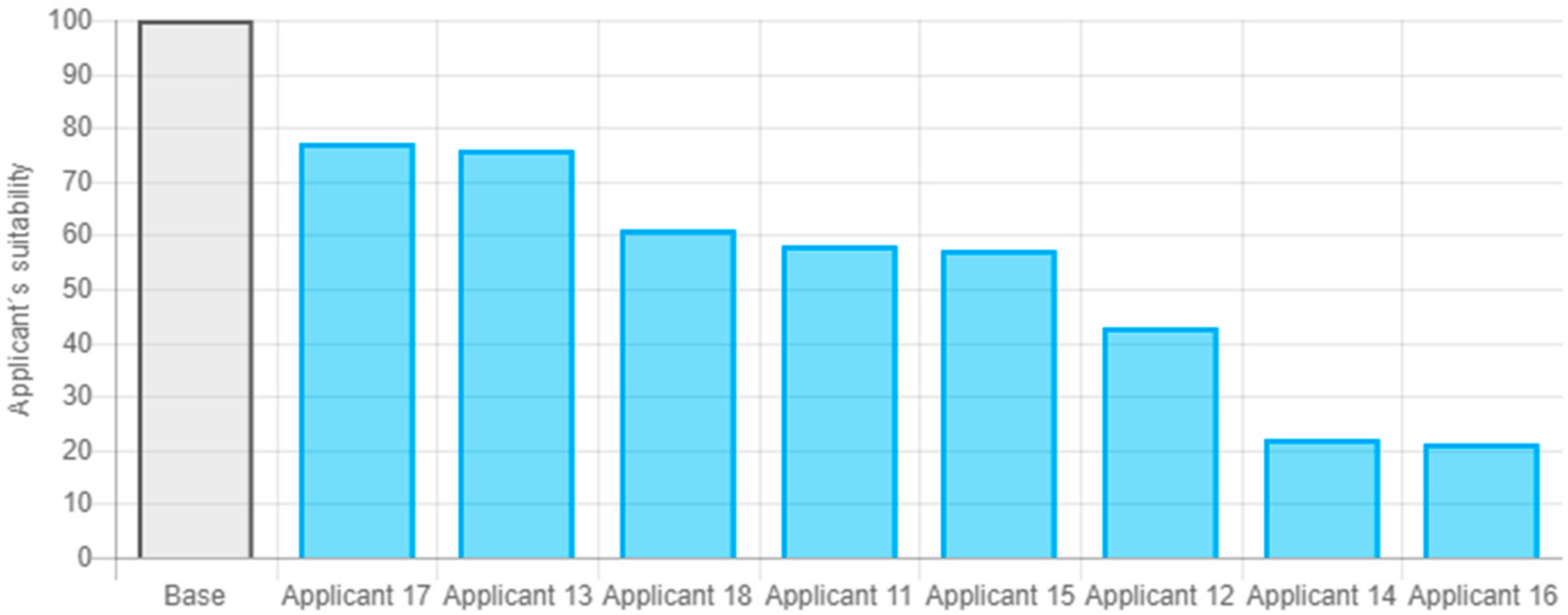The first level of evaluation in this system consists in a multi-criteria analysis. This method is convenient for our purposes due to its predefined number of inputs—each job position can have a different number of criteria necessary to evaluate. In the case of using a certain type of an expert system (e.g., Mamdani), the knowledge base would have to be created for each position individually meaning that the number of rules would be huge and their consistency unbearable in the case of a higher number of criteria.
Therefore, a multi-criteria analysis offers a universal tool for the evaluation calculation of a group of criteria without prior knowledge of their exact number. This calculation takes into account particular applicant’s evaluation in such criteria as well as their importance.
Evaluation of Applicants’ Qualities Using Multi-Criteria Analysis
In this step, each applicant’s qualities are evaluated using a multi-criteria analysis. The step is divided into several sub-steps, which are described individually.
Determination of ranges. Each criterion which is used to evaluate applicants must have a range of vague expressions which the criterion can reach. The implemented system will then have predefined general ranges which enable it to be supplemented with ranges defined by the user.
Each range should contain the expression “Unknown” as it will be default set and its whole number value will be 0. Other vague expressions will correspond with higher numbers. These whole numbers will then be used for the calculation.
The only exception are criteria of “length of experience” type which then will be evaluated using a whole number which will state the real length of experience.
For instance, criterion “HTML 5” in
Table 1 has a range composed of values “Nothing”, ”Beginner”, “Apprentice”, “Wizard” and “Guru”. Expression “Nothing” corresponds to a number value 0 and “Guru” to value 4.
Determination of criteria importance. Concerning user friendliness of the system, determination of criteria importance will use only one to five points. These points will be of the following values in the calculation 1/5 to 5/5.
For instance, criterion “HTML 5” in
Table 1 has set value of importance 4, which is almost the highest importance.
Calculation of evaluation for one criterion. Calculation of evaluation for individual criteria for each real applicant is performed using the method of weighted sum. This sum takes place as a product of the value which the HR officer evaluated for the given criterion and the ratio of the importance of the given criteria to the overall number of importance degree.
where
is evaluation of the criterion
i for applicant
j,
is the value of criterion
i for applicant
j,
is the importance of criterion
i, and
is the overall number of the degree of importance.
For instance, for the selected applicant in
Table 5, the calculation of criterion “HTML 5” is
.
Here, the years of experience are recalculated with a value which then enters the multi-criteria analysis using the optimal years of experience in the model of the job position and the set type of such attribute behavior. The most common case is that in case the applicant’s evaluation exceed the optimal years of experience, the multi-criteria analysis calculation uses the optimal years of experience. In the opposite case, it could result in distorting the whole evaluation just on the basis of one longer experience which exceeds the optimal length set in the model.
For instance, for the particular applicant in
Table 5, the criterion optimum years of experience for “HTML” has the value which is set as optimal in
Table 3. In this case, the value stated by the applicant (6 years) is not used, but rather the optimal years of experience for this criterion “HTML”—3 years.
Calculation of applicant’s suitability based on criteria. The last step of this evaluation is the calculation of each applicant’s suitability in the given category. This calculation is the sum of evaluations in all criteria for the given applicant.
where
is evaluation of applicant
i and
is evaluation of criterion
j for applicant
i.
For instance, for the particular applicant in
Table 5, this resulting value for hard skills, soft skills, and years of experience is
.
Normalization of applicant’s suitability. In order to normalize an applicant’s suitability in percent, so-called basic alternative, which is considered for an applicant evaluated as 100%. It then concerns an ideal applicant which can be really met only very rarely. Percentage suitability of each real applicant is calculated based on this reference value.
The calculation of the base is done in such a way that there is a calculation of applicant’s suitability and individual values of criteria are the maximum range values.
For instance, for the job position in
Table 1, criterion “HTML” is set to “Guru”, its numerical value respectively, i.e., 4. The overall evaluation of this maximum base is
.
The applicant from
Table 5 then has the evaluation corresponding to 67.8% of the maximum base (ideal applicant).
Evaluation of the interview. In this step, the HR officer fills the system with an overall evaluation of the interview for a given applicant. This evaluation is, once again, undertaken using a predefined range and it has an impact on the final evaluation of the applicant.
For instance, for the particular applicant in
Table 5, the interview evaluation reaches value 4.4 and the interview evaluation of the maximum base is 6.2. This means that the applicant reached the evaluation of 70.9% of the interview evaluation of the maximum base.
Final evaluation. The final evaluation consists in processing inputs from both evaluations with the ratio of their importance. Thanks to the use of a fictional best applicant, it is easy to normalize its outputs into percent or any other interval.
For instance, for the particular applicant in
Table 5, the interview evaluation reaches value 4.4 and the interview evaluation of the maximum base is 6.2. This means that the applicant reached the evaluation of 70.9% of the interview evaluation of the maximum base.
The algorithm of the final evaluation is to take into consideration the output states of both preceding multi-criteria analyses. Another thing to take into consideration is the information of which multi-criteria analysis is of a higher importance. There are job positions where applicant’s impression of the HR manager is more important than the assessed qualities and in some job positions it is vice versa.
Of course, there are a number of algorithms to be used for this purpose. The simplest is the method of the weighted sum, which determines the weights according to the importance of individual inputs. More complex behavior would rather be difficult to formalize.
A more formal process of evaluation could use some type of an expert system. Various alternatives and numbers of inputs can be processed, after defuzzification, using IF-THEN rules of Mamdani type. In such a case, there would be a need for a high number of rules in order to cover all possible combinations of linguistic expressions of the input variables. This fact would mean difficult tuning of such a system and even more difficult future modifications.
Due to the aforementioned reasons, the final evaluation process uses an expert system of the Takagi-Sugeno type. Thanks to the shape of IF-THEN rules, it is possible to work only with only one input variable in the antecedent, which expresses the importance of both input values. In consequence, there are numerical values of both inputs as a sum. These values, in multiplication, are then added with coefficients which take into consideration the importance of each input.
In future, using the Takagi-Sugeno type system is very beneficial in the way that if there is a need to implement, for example, behavior in zero evaluation of one input, the output must be zero, too. It means adding one more rule into the knowledge base and adjusting the antecedent of the existing rules.
Inference fuzzy system of Takagi-Sugeno type. The first ideas if the inference fuzzy system of the Takagi-Sugeno type were set down in [
34]. The characteristics of the Takagi-Sugeno system make it usable in various types of system [
35,
36,
37].
The objective of this method is to develop an intuitively behaving evaluation system for given inputs, which would be easily adjustable to user needs. This method works in a way that based on a fuzzified value of an input variable “ratio of input importance” (“IMPORTANCE”), a linear function in the consequent of the given rule is selected.
The input variable “ratio of input importance” is fuzzified according to
Figure 3 below. The first fuzzy set “first” represents a state when the most important is the first input (“QUALITIES”). In the case of set “both”, both inputs are of the same importance and in the case of set “second”, the most important is the second input (“INTERVIEW”).
Next two input variables (“QUALITIES” and “INTERVIEW”) are not a subject of defuzzification as they appear only in linear functions of IF-THEN rules consequents. These rules are provided below.
The output variable “SUITABILITY” is then a result of a linear function of the selected IF-THEN rule. Coefficients
Ca1,
Cb1,
Ca2, and
Cb2 determine the influence of importance on the ratio of individual parts in the final evaluation. For the needs of this evaluation, the coefficients were determined empirically so that the influence of the importance was equally distributed to both input variables. The values of these coefficients are provided in the
Table 6.
When graphically depicted, this evaluation is of a linear area shape, which rotates around its diagonal of the given space when importance is changed, see
Figure 4.
